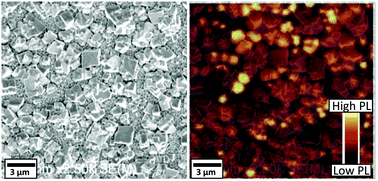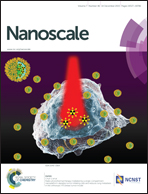Analysing the effect of crystal size and structure in highly efficient CH3NH3PbI3 perovskite solar cells by spatially resolved photo- and electroluminescence imaging†
Abstract
CH3NH3PbI3 perovskite solar cells with a mesoporous TiO2 layer and spiro-MeOTAD as a hole transport layer (HTL) with three different CH3NH3I concentrations (0.032 M, 0.044 M and 0.063 M) were investigated. Strong variations in crystal size and morphology resulting in diversified cell efficiencies (9.2%, 16.9% and 12.3%, respectively) were observed. The physical origin of this behaviour was analysed by detailed characterization combining current–voltage curves with photo- and electroluminescence (PL and EL) imaging as well as light beam induced current measurements (LBIC). It was found that the most efficient cell shows the highest luminescence and the least efficient cell is most strongly limited by non-radiative recombination. Crystal size, morphology and distribution in the capping layer and in the porous scaffold strongly affect the non-radiative recombination. Moreover, the very non-uniform crystal structure with multiple facets, as evidenced by SEM images of the 0.032 M device, suggests the creation of a large number of grain boundaries and crystal dislocations. These defects give rise to increased trap-assisted non-radiative recombination as is confirmed by high-resolution μ-PL images. The different imaging techniques used in this study prove to be well-suited to spatially investigate and thus correlate the crystal morphology of the perovskite layer with the electrical and radiative properties of the solar cells and thus with their performance.


 Please wait while we load your content...
Please wait while we load your content...